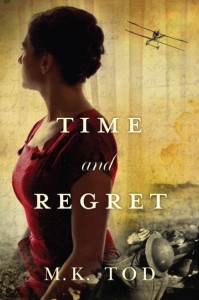What do The Ashford Affair by Lauren Willig, The Labyrinth by Kate Mosse, The Light in the Ruins by Chris Bohjalian, The Muralist by B.A. Shapiro, and The Lost Sisterhood by Anne Fortier have in common? Answer: they are all dual-time mysteries. I love reading stories like these. But writing one proved to be a significant challenge and demanded a different approach from my previous historical novels.
So what did I learn? Below are eight tips for crafting this type of story.
- Are you telling two stories or one? You need to be clear on whether you are telling two stories or one. In other words, the links between each timeline, the character arcs, and essence of the mystery need to integrate seamlessly into one satisfying read. Each timeline must enhance the other. If you conclude that you are telling two stories, you really should write two books.
- Both timelines have to engage the readers – finding the balance is critical. I once read only the present day portion of a novel because the historical portion was confusing and added almost nothing to the story. In another instance, my review suggested that the present day story was very thin and could have been eliminated.
- Whether separated by fifty years or five hundred, your novel will have two protagonists, one for each time period. Readers must care deeply about both of them. Furthermore, the present day character should be more than merely a narrator for a story set in the past.
- Each protagonist must have a distinct voice. Your readers should never be confused about who is in charge of the story at any given point. The thinking, inner dialogue, and perspective of each protagonist should set them apart.
- Beyond the distinct voices of your protagonists, readers must be clear about which era they’re in at any point in the novel. This requires careful attention to setting, dialogue, behaviours, events of the time period, possessions, attitudes, and other elements that alert a reader to the era.
- Plotting a dual-time mystery is even more complicated than a regular mystery. Clues will emerge from each time period. I developed a table to track every clue regardless of time period and its relevance to the overall mystery. And if you want your readers to puzzle out the mystery as they read, be careful that the earlier storyline doesn’t reveal too much of the mystery too soon.
- Avoid jumping back and forth too frequently. Readers need to engage sufficiently in each story before you change the characters and time period. This piece of advice is particularly important in the early chapters when you are establishing characters and setting, creating hooks, and revealing the central questions the story will answer.
- The rules of excellent historical fiction still apply. In a 2013 reader survey I conducted, readers said that the top three reasons they read historical fiction are: to bring the past to life, because it’s a great story, and to understand and learn without reading non-fiction. To augment that data, in 2015 readers chose immersed in time and place, superb writing, characters both heroic and human, authentic and educational, and the dramatic arc of history as the top 5 factors in favourite historical fiction. (You can find more survey insights on www.awriterofhistory.com.)
Mysteries are a favourite for fans of historical fiction; 40% of participants in a 2015 survey chose mysteries as one of their top three types of stories to read. Write your dual-time mystery well and it will appeal to mystery lovers as well as lovers of historical fiction.
M.K. Tod writes historical fiction and blogs about all aspects of the genre at A Writer of  History. Her latest novel, TIME AND REGRET will be published by Lake Union on August 16, 2016. Mary’s other novels, LIES TOLD IN SILENCE and UNRAVELLED are available from Amazon, Nook, Kobo, Google Play and iTunes. She can be contacted on Facebook, Twitter and Goodreads or on her website www.mktod.com.
History. Her latest novel, TIME AND REGRET will be published by Lake Union on August 16, 2016. Mary’s other novels, LIES TOLD IN SILENCE and UNRAVELLED are available from Amazon, Nook, Kobo, Google Play and iTunes. She can be contacted on Facebook, Twitter and Goodreads or on her website www.mktod.com.

Great advice, M.K. I enjoy a story that combines past and present when all these elements are involved. It makes the reader feel like they’re a part of both worlds, not just the present one. It’s also a good way to get background on the present protagonist sometimes without it feeling stiff and uninteresting.
Thoughts in Progress
and MC Book Tours
That’s an excellent point, Mason Canyon. I should add it as tip #9. Thanks for your interest. M.K. (Mary)
You’re writing about two main characters who just happen to occupy two different places in time.
I think it would be a huge challenge. So much to keep track of.
You’re right, Alex. I had spreadsheets and outlines galore! Thanks for your interest, M.K (Mary)
Thanks so much for blogging today, Mary! I love your tips for tackling this type of complex story. I love reading these types of books, but writing them always seemed intimidating. Congratulations on your new release!
Many thanks, Elizabeth. And thanks for hosting me! Warm regards, Mary
This is really good advice! I think the one that resonates the most is to keep both timelines interesting and engaging. If both timelines aren’t engaging, the story feels ‘lopsided.’ Wishing you much success!
Many thanks, Margot. I’m excited to launch another book! Keeping my fingers crossed that it will do well. Best, M.K. (Mary)
Smart tips. What’s the best rate of going back and forth? Every other chapter?
Really good question, Diane. I think you need to switch back and forth every one or two chapters, but it does depend on how long those are and where the momentum of the story lies and probably many other items! Thanks for your comment, M.K. (Mary)
I love reading dual narrative stories and I love writing them. Thanks so much for the tips!
Thanks, Elise.
The only dual time mystery I have ever read was the Longmire mystery: Another Man’s Moccasins. I’d just get caught up in the Viet Nam murder when I was pulled back to the Wyoming one. It was not my favorite Longmire! :-)
Hi Roland … I’ve never read Longmire. Will have to add them to my list.